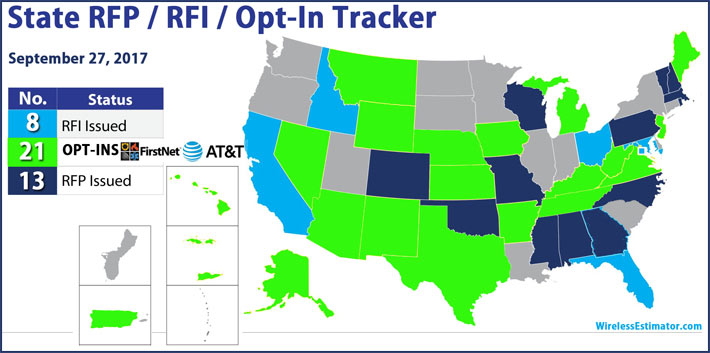
Georgia recently issued a request for proposals (RFP) asking bidders to submit proposals to build and maintain an alternative LTE radio access network (RAN) for FirstNet under a potential “opt-out” scenario, making Georgia the 13th state with an active procurement for an alternative-RAN vendor.
Georgia released the RFP on Sept. 22, and bids are due on Oct. 24. The proposed alternative RAN would be known as the Georgia Public Safety Broadband Network (GAPSBN) and would only be constructed if the state completes all of the tasks necessary to gain “opt-out” status, as outlined in the 2012 federal law that established FirstNet, according to the RFP.
Language in the RFP notes that “hardening of the network to public-safety grade is a primary requirement of the state,” and that Georgia’s alternative RAN would cover “greater than 98% of the state’s geography and 99.5% of its population.” Vendors should utilize the 20 MHz of 700 MHz Band 14 spectrum “to the greatest extent possible,” according to the RFP.
From a financial standpoint, the RFP notes that the state of Georgia has not appropriated any funds for the proposed alternative RAN, so vendors need to leverage excess network capacity from the RAN to make the system self-sustaining financially. Vendors need to ensure that they can do this while providing service to users at fees that “will be maintained at the lowest practical level” and making payments to FirstNet for the use of its core and licensed spectrum—costs that are not yet known.
Most governors will have at least until Dec. 25 to decide whether their states and territories will “opt-in” to FirstNet or pursue the “opt-out” option after the National Telecommunications and Information Administration (NTIA) on Monday failed to provide key funding information for states that achieve “opt-out” status.
Last week, FirstNet updated the state-plan portals for all 50 states and three territories—the South Pacific territories of Guam, American Samoa and the Northern Mariana Islands have not received initial state plans.
But NTIA did not release the funding level determination (FLD)—the amount of construction-grant money a state or territory could receive in an “opt-out” scenario—as of Monday, multiple sources confirmed to IWCE’s Urgent Communications. As a result, the statutory 90-day period for governors to make their “opt-in/opt-out” decisions has not yet started.
If the NTIA releases the funding levels today, the 90-day period technically would conclude on Monday, Dec. 25—a federal holiday for Christmas—for the 50 states and three territories. In this case, governors presumably would be given until Tuesday, Dec. 26, to provide their decisions.
No official explanation for funding-level delay has been provided, but multiple industry and Beltway sources have speculated that that NTIA construction-grant program theoretically could be very large—exceeding more than $1 billion—so the number of approvals needed within the government likely would be considerable, according to FirstNet Georgia.

















